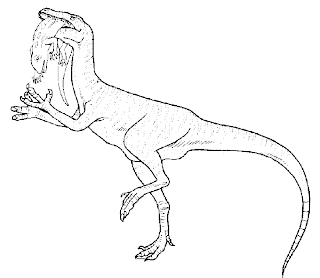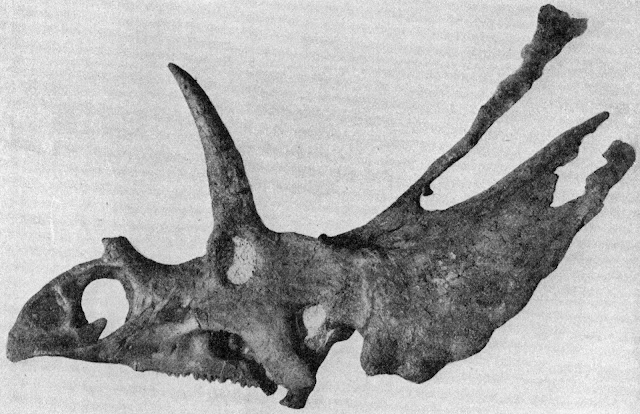![]() |
| Adopted from Sampson SD, Loewen MA, Farke AA, Roberts EM, Forster CA, et al. 2010 |
Pentaceratops had, arguably, one of the largest frills (a parietosquamosal caudal extension of the skull) in its family. Chasmosaurine ceratopsians typically had larger frill areas than centrosaurs and protoceratopsids. There are always a few exceptions to every rule (Styracosaurus for example had a rather large frill for a centrosaurine ceratopsian), but it does fit as a general rule that a large frill belongs to a chasmosaur. The eyebrow (orbital) horns are also quite extensive and curved downward (the bird world would call this a decurved horn but some here may refer to this as rostrally or ventrally curved). The small nasal horn curves slightly backward but does not reach such a length that the curvature becomes highly pronounced. Fenestrations of the parietal are found in the frill which serve to lighten the bone mass, as in most ceratopsians, and the skull is joined to the postcranial vertebrae in a complex joint that allows movement somewhat like that of a ball and socket joint.
References
Sampson, S. D., Loewen, M. A., Farke, A. A., Roberts, E. M., Forster, C. A., Smith, J. A., & Titus, A. L. (2010). New horned dinosaurs from Utah provide evidence for intracontinental dinosaur endemism. PLoS One, 5(9), e12292.
![]() |
| ©Nobu Tamura |
When the skull is turned even slightly away from a direct lateral view we can see that the frill forms a rather large U bend in the center of the dorsal end of the frill. The small hornlets, or epiparietal horns, are turned down and forward (decurved/rostral and anterior facing). Also we can see that skin stretched tightly over the entire frill would accent the fenestrations by being "sucked" into the bony windows slightly but enough that we would be able to notice them. This theme occurs constantly in the recreation of ceratopsians and, given the idea that the fenestrations existed to lighten the bone rather than house important organs, it makes a great deal of sense that skin and other tissues above those holes would not disguise their existence by puffing outward or anything of the like.














